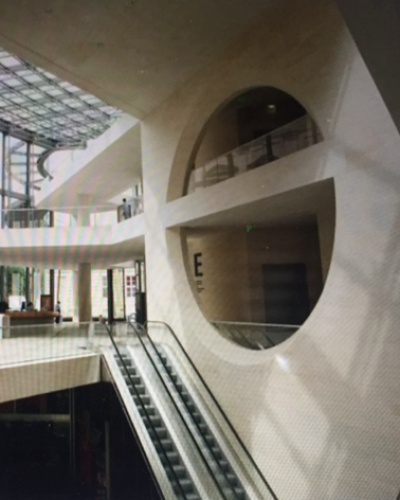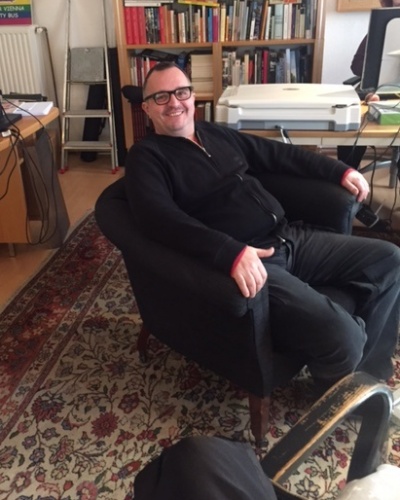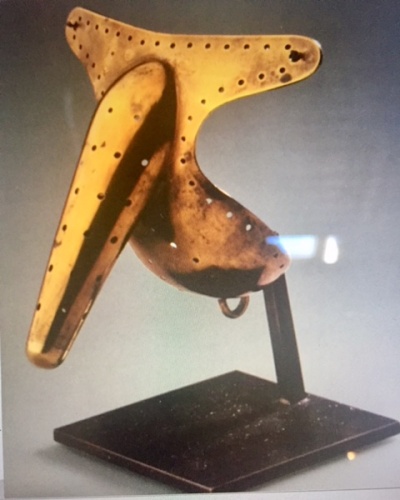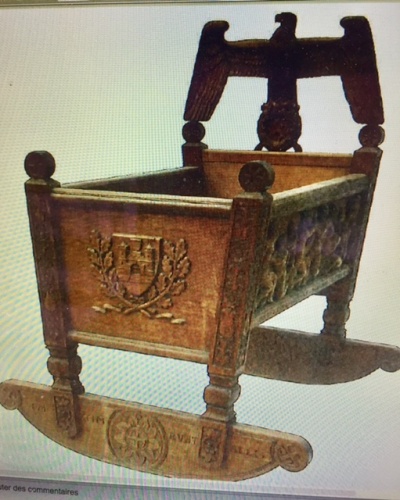A queer travelogue: Two exhibitions in Berlin and Vienna
Robert Schwartzwald
Université de Montréal
Recently, I had the good fortune to visit two remarkable exhibitions on sexuality in Berlin and Vienna. In the German capital, the “Homosexualities” show was held over two sites in 2015, the German Historical Museum and the Schwules Museum, while “Sex in Vienna” followed in 2016 at the City of Vienna Museum. I was also lucky enough to speak with some of the curators responsible for each.
The first time I visited the German Historical Museum (DHM) was in 1978. Or, to be more precise, I visited the building’s previous occupant, the Museum of German History (MDG) located in what was then East Berlin, the capital of the German Democratic Republic. On the Day of Unification (October 3, 1990) the MDG’s premises on the Unter den Linden boulevard were delivered to the DHM, founded by the Federal Republic three years earlier in 1987. When I returned for the “Homosexualities” show in October 2015, the gloomy interior courtyard of the original eighteenth century Zeughaus building had had a makeover: it was now a luminous, covered space that led to a striking new pavilion for temporary exhibitions designed by I.M. Pei, the architect behind the entrance pyramid to the Louvre in Paris and, a quarter century earlier, Montreal’s own Place Ville-Marie. On the day of my visit, the entrance foyer to the original building was thriving with schoolchildren gleefully photographing each other as they posed under the pendulous testicles of the titanic male nudes of Arno Breker, Hitler’s favourite sculptor. Fully-clothed DDR statues of Lenin and Marx, conserved from the MDG’s collections, glowered nearby!
A second part of the exhibition, devoted to visual and media arts, took place at Berlin’s Schwules Museum (“schwul” is a colloquial term; an English equivalent would be “fag”). Founded in 1985 and a well-known pilgrimage site for LGBTQ tourists, the museum moved in 2013 from its location in the formerly bohemian West Berlin neighbourhood of Kreuzberg to the ground floor of a modern condo building in the heart of western Berlin, not too far from the Bauhaus Archive. Over the years, the museum has produced a remarkable series of exhibitions, largely under the curatorship of Birgit Bosold, director of exhibitions and finance. It has been receiving regular state funding since 2010, although it has benefited from state support for specific projects since 2004, including the development and installation of the permanent exhibition. The “Homosexualities” show was funded by both federal and state cultural agencies and wouldn’t have been possible without it, according to Bosold.
Almost a year later, I found myself at the “Sex in Vienna” exhibition. The City of Vienna Museum is a bland, functional affair that opened in 1958. Sitting in proximity to opulent 19th century Beaux-Arts hotels, the Baroque Karlskirche and the neo-classical temple to music, the Musikverein, it is a stern visual statement about Austria’s abrupt transformation from the seat of a glittering empire to a small republic on the edges of western Europe. Today, Vienna burgeons with migrating youth from across Eastern Europe and even Germany (reversing a decades-old trend) and is set to equal its imperial pre-World War I population in the foreseeable future. Fittingly, the museum is slated for an expansion that will actually engulf the existing structure. It’s a self-confident, contemporary statement in a neighborhood dominated by the glories of ages past.
In Vienna, the City Museum’s new Director Matti Bunzl appointed a curatorial team of six, including Andreas Brunner and Hannes Sulzenbacher, founders of Zentrum QWIEN, Vienna’s centre for gay and lesbian culture and history. Bunzl knew the two since his days as a doctoral student, before QWIEN was founded, when the two pioneering gay historians helped him locate sources for his own research.
QWIEN officially opened in 2010, but its origins lie in earlier LGBT cultural festivals, before discussions with city officials convinced them to redirect Vienna’s “gay money” from the culture “envelope” to the archival one. The first exhibition to benefit from this shift was “Geheimsache: leben” (“Lives: Top Secret”), held in 2005-06. It was the work of eight full-time researchers, and unsurprisingly, there was too much material to process in time for the exhibition. This, too, provided a compelling argument that led city officials to accept the proposal to found an archive/library/research institute. The story is told in the film “Stonewall in Vienna” (a shortened version can be found on You Tube).
Today, Zentrum QWIEN is heavily subsidized by the city – only the ultra right-wing Austrian Freedom Party (FPÖ) routinely objects. It also receives support from private foundations and the University of Vienna. The Centre officially collaborates with the Vienna Tourist Office, the Vienna anti-discrimination office, and the committee responsible for planning the city’s memorial to LGBTQ victims of the Nazis. More than twenty people work at the Centre. They represent a mix of ages and life experiences: some are on contract, but there are also volunteers from schools, the university, and a state-sponsored training program for the unemployed. Some are students fulfilling their internship requirement, others are conducting research, and still others are there just for fun.
Very few regulars at Zentrum QWIEN are from immigrant backgrounds. Sulzenbacher explained that the LGBTQ migrant gay community is not large, and those who are active, I was told, “are not interested in history” (although to be fair, he was convinced that almost no one under the age of 40 was interested in gay history!). QWIEN does collaborate with Vienna’s annual immigrant film festival and offered special tours through the “Sex in Vienna” exhibition to immigrant groups. There’s currently a project being prepared on the representation and recognition of the “Oriental man” in Central Europe.
STICHWORT, an “Archives of the Women’s and Lesbians’ Movement” in Vienna, also provided some objects for “Sex in Vienna”. Its website describes “a women-only space and a place of feminist debate for women; at the same time, the archives are accessible to transgender persons.” Normally, cisgender men do not have access to the archive, so “Sex in Vienna” presented them with a unique opportunity to view selections from its collection.
According to Bunzl, the original exhibition concept had been to focus on the sexual topography of Vienna, but with an eighteen-month timeline, this proved too cumbersome and without a clear guiding thread, so a new approach was needed. Brunner and Sulzenbacher explained to me how the curators didn’t want to do an exhibition on the persecution of sex, but on doing sex, in other words a sex-positive exhibition that, despite persecution and criminalization, showed that “sex should/could be fun and was always so.”
Unlike the capacious installations of the “Homosexualities” show in Berlin, the smaller exhibition galleries in Vienna were practically bursting at the seams. The day I visited, personal space was for all intents and purposes non-existent. It was simply impossible to entirely avert the gaze of others while taking in the plethora of exhibits that featured four hundred years of sexual places, practices, and devices, be it a dildo or a masturbation strap (a kind of chastity belt for boys, and so the opposite of what the name suggests). Instead, bodies lightly jostled each other for visual advantage as visitors found themselves bunched together around display cases engorged with artifacts and interpretive panels. It occurred to me that this was entirely appropriate for an exhibition that opened with a Prologue dedicated to “The Gaze” and concluded with a section entitled “After Sex is Before Sex.” Who knows how many took this axiom to heart after exiting the show? Quite a few, I suspect: during its run, “Sex in Vienna” attracted some 76,800 visitors! It enjoys the distinction of being the City of Vienna Museum’s most successful exhibition ever; the previous record was 65,000. In Berlin, too, attendance was impressive: some 85,000 visitors came to the German Historical Museum, a number comparable to other major exhibitions, while with 15,000 visitors, the Schwules Museum achieved a new attendance record. In 2016, the exhibition moved to the Westphalian State Museum in Münster.
In Berlin, the DHM required that a porno balken, or barrier, be installed, with the warning that images displayed in some of the galleries were sexually explicit. According to German law, such images are prohibited for those under the age of 18. But the text went on to express its reservations about this obligation: “Exactly what falls under the term ‘pornography’ is, however, not legally regulated. Today the term is reduced to notions of increases in sexual pleasure because of explicitly sexual representations ‘which according to general social ideals clearly exceed the limits of sexual decency’ (Commentary of the Munich Criminal Code, 2012).” The DHM also placed restrictions on access to some of the catalogue contents in the exhibition halls themselves. According to Andreas Brunner, who was also a consultant to the Berlin show, the Vienna team took note for their own exhibition and decided not to make any concessions in this regard. Instead, they “X-rated” the entire show and restricted admission to those eighteen years and older, in no small part, he explained, to head off anticipated attacks from the Catholic Church and conservative political parties.
Consistent with the German Historical Museum’s mission, the Berlin show had a national focus – or bi-national, if one takes into account the 40-year history of the DDR – but material from other countries was also introduced when deemed pertinent. In Vienna, the vast majority of artifacts were from, or about, Vienna itself; only occasionally did the show look farther afield. More broadly, however, it would not be doing an injustice to either to say the Berlin show was organized along the lines of “before, during, and after (homo)sexual identity,” while the Vienna show was organized along the lines of “before, during, and after sex.” This distinction was already clear in the opening sections of each, “The First Time” in Berlin and “Before Sex” in Vienna. “The First Time” featured a number of objects in vitrines, each attached to the memory of an initial “anti-normative” sexual experience. Most of the objects were not in and of themselves particularly sexual, but they were intimately bound up with experiences that led to the realization that “I am different” (Anders als die Andern, – Different from the Others – as the title of the classic German film from 1919 would have it). A kind of “coming out” Call for Submissions had been issued for this section, inviting contributions from “those who have resisted heterosexual norms derived from binary concepts of identity.” The arbitrary and random quality of many of the featured objects made this part of the exhibition particularly delightful, but the objects also served an ulterior purpose: they were presented as catalysts for the formation of dissident sexual identities that clustered into organizing principles for living lives. Here, in other words, a “first time” presages, or announces, a “new life.”
In Vienna, a ‘first time’ bears no such promise: as the exhibition’s quip would have it, the first time is merely a prelude to another (and another!). There was little interest in fitting sequences of sex acts into narratives of “blossoming” identities. Instead, the show’s temperament was often playful and reminded me of the lyrics to Cole Porter’s “Let’s Do It!”: “Birds do it, bees do it, even educated fleas do it!” Thus, “Before Sex” was devoted to exploring how, over centuries, the Viennese set about making their sexual desires known to each other, either through socially sanctioned codes or, more inventively, outside them. “During Sex,” the second and largest section, chronicled the kinds of sex that have been encouraged and even invented over the centuries, and the spaces that have hosted or been created for these activities. This section also documented the kinds of sex have that have been discouraged and repressed at various moments, through which means, and why. Finally, it asked how people having sex, or wanting to have it, negotiated these various incentives and prohibitions, including attempts to get around, or even subvert, them. The final section, “After Sex,” examined anxieties arising from sex acts, including possible pregnancy (or its termination) and disease, but also how people felt about what they had just been up to and, crucially, how they dealt with these feelings. These are appropriate questions, of course, in a city known for a powerful Roman Catholic Church and the invention of psychoanalysis!
By way of contrast, the Berlin show (re)constructs categories of sexual identity historically before going on to interrogate and destabilize them. Especially in the closing sections of the exhibition, the insights of Queer Theory are brought to bear on earlier sexological and essentialist approaches. With identity, of course, come the tropes of dignity, respect (and self-respect), autonomy, self-determination – and their opposites. The Berlin exhibition explored these both diachronically (the history of the struggle for recognition and rights in Germany) and through a cross-sectional examination of religious, legal, and medical discourses in given periods. The “In Court” section scrupulously documented judicial treatments of “sodomy”, immorality, and prohibited forms of sexual behavior over the centuries. It also featured a huge wall map of the current legal status of homosexuality worldwide. One of the most notorious items in the entire exhibition was to be found in this section. It “said” nothing, but spoke volumes: the calling card left for the father of Lord Alfred Douglas, the Marquess of Queensberry, by Oscar Wilde. This prim, innocuous card would trigger the vicious and humiliating chain of events that would lead to the Irish writer’s conviction, and imprisonment. Borrowed from an anonymous British source, I was told it cost more than all the other loans combined!
The Vienna exhibition also documented the ways in which sex has been disciplined to both reflect and solidify relations of property and privilege. However, the curators chose to intersperse such materials with other kinds of documentation to argue that regardless of the extent of sexual policing, or attempts to establish normative codes for sexual behavior, that sex, undisciplined and lots of it, had its way. Brunner and Sulzenbacher’s view is that until relatively recently, the threat of state violence remained distant for most people who enjoyed having same-sex encounters. This was because the bourgeois standards of behaviour required by modern notions of sexual morality, and therefore of deviancy and criminality, had not yet been extended to them. “The masses”, it seems, did not (yet) feel implicated or recognize themselves as the targets of this moral policing, and instead simply went about their horny business. “In a big city like Vienna, sex will always happen,” explained Sulzenbacher. “A metropolis is a room of sexual possibilities that helps people with specific interests find each other.” In particular, the19th and 20th century city made possible “special interest sex” without overbearing social control; “it lay new possibilities before you.”
For Sulzenbacher, even the most prolific documentation of sexual “vice” in state and police archives is but a sorry testament to an unlucky minority who were caught and punished. And Brunner insisted, “There may have been 300 guys in prison (during the Nazi period), but 3000 others were having sex outside and enjoying it.” Following the 1938 Anschluss of Austria, he went on to explain, the Gestapo gave most gay cases in Vienna back to the criminal police after an initial year and a half of double policing. Only ‘political’ cases, i.e., cases where homosexual activity could be used to blackmail, entrap, or extort information from an ideological opponent, were retained by them. The Nazis knew about gay bars in Vienna, but unlike in Berlin, never closed them. The bars remained more or less intact, Brunner explained, until the new sexual morality campaigns that accompanied the post-war Austrian republic led to the disruption of longstanding homosexual spaces.
The Berlin exhibition treated the NSZeit (Nazi era) with utmost solemnity. The large “Pink Triangle” gallery, set off from the rest of the exhibition, featured the testimonies of homosexual men and lesbians persecuted by the Nazis for their “anti-social” behavior. The exhibition catalogue notes “their stories stand for all the others we will never hear.” Under Paragraph 175, about 100,000 men were rounded up as homosexuals under the Third Reich, while approximately 10,000-15,000 were deported to concentration camps. Homosexuality was anathema to the idea of the Volksgemeinschaft, the racialized “Aryan” community, since its adepts not only spurned physical reproduction but also threatened to lead youth astray from their patriotic, biological, and marital duties. The force of this idea was creepily on display in the Vienna exhibition, which featured a “Nazi cradle,” probably used in name-giving ceremonies meant to replace baptisms, and adorned with inscriptions such as “The seed contains all” and “Mother Nature gave you German blood: keep it pure, for it is your greatest possession.”
The poignancy of “Pink Triangle,” however, resided in its documenting of the continuing, and often intensified, humiliation endured by victims in the decades following the end of the Second World War. In West Germany, homosexuals who had been imprisoned in Nazi labor and concentration camps because of their sexual orientation – the “pink triangle prisoners” – were ineligible for either compensation or pensions. To receive support, they were often coerced into remaining silent about what had happened to them. Heartbreaking stories of lovers torn asunder by blackmailing families and of ageing victims living in poverty and loneliness paint a devastating portrait of people twice victimized: first by the Nazis and then by the reactionary policies of the Federal Republic.
In Berlin, the topic of shame was further explored in an innovative audio gallery, “Shame and Disgrace,” devoted to a historical survey of homophobic invective, and set up as a long corridor painted in warm colors with comfortable, upholstered benches and strategically located at about the halfway point in the exhibition route. The visitor gratefully settles in to relax before realizing that the surrounding speakers are blaring hateful and absurd ravings about same-sex desire made by clergymen, scientists, politicians, and other public figures over the centuries. For a few minutes I sat and listened, fascinated in a lurid kind of way, but it wasn’t long before I felt the urgent need to move on!
The Berlin exhibition devoted considerable resources to the work of the sexual reformers. Kraft-Ebbing, Ulrichs and Hirschfeld all received scrupulous attention, and if their efforts at social reform were presented as praiseworthy – especially Hirschfeld, thanks to his untiring efforts to achieve the decriminalization of homosexuality through the repeal of Paragraph 175 of Germany’s criminal code)- the sexological theories that dominated the late 19th and early 20th centuries come across as deeply injurious. Visitors make their way through a display of all manner of contraptions produced to measure deviance and ‘cure’ it. These often cruel devices were the unhappy progeny of the marriage between medicalized discourse about sex and technological “advances”. Many were influenced by the theories of inversion that held sway at the time, and the nonconsensual efforts to eliminate the “contradiction” of a woman’s soul ‘trapped’ in a man’s body (or vice-versa) appear particularly reprehensible today. And so, it was not surprising that some transgender militants took great exception to this part of the show, claiming that the display itself was a form of violence, or re-victimization. Bosold acknowledged the conundrum when I spoke with her: in a historical museum, was there not a duty to display this past, as painful as it might be? She allowed that the exhibition failed to provide the critical resources to move beyond the suffering to which these items still bore witness, in large measure because the past isn’t necessarily in the past at all. The itinerary of the exhibition, which led from this section to another on Queer Theory, was not in itself an adequate solution.
Along similar lines, it is significant that the only serious disagreement between the Berlin curators and the DHM involved the exhibition poster, featuring an image by Montreal-born artist Heather Cassils. “Advertisement: Homage to Benglis” is part of a larger body of work, “CUTS: A Traditional Sculpture,” a six-month “durational performance” from 2011. It pastiches work by American artist Lynda Benglis to present a forceful, striking trans model with a ripped torso, “softened” feminine breasts and jaw, wearing a jockstrap. The Historical Museum worried that it presented a confrontational, alienating representation of lesbians and gay men and wasn’t a suitably historical representation of their struggles. But criticism came from “the home team”, too: some activists argued that it depicted lesbians and gays as monsters instead of inspirational embodiments of the diversity of human sexuality, while some transgender activists attacked the curators for misappropriating the image for a “gay show” with a transphobic result. The curators defended the image, claiming that it was consistent with the show’s vector, which led to the final section, “What’s Next?”, where binary definitions of gender and sexuality are presented as very much on the trailing edge of history.
In the Berlin exhibition, the “Golden Age” of Gay Lib is given pride of place in “Savage Knowledge,” a zone of A to Z documentation of LGBTQ events, places, and personalities beginning in the late 1960s. The design concept of this part of the exhibition is meant to communicate the often spontaneous, irreverent street-based militancy of the period. Here, display boards interspersed with artifacts relate often un-remembered moments in late 20th century LGBTQ struggles. The texts and images of these exhibits fill most of the pages of the exhibition catalogue. It became clear to me, as I toured this part of the show, that one of the curatorial intentions was to break with the “Weimar myth,” perhaps best known through the writings of Christopher Isherwood and his friends W.H. Auden and Stephen Spender, and especially the adaptation of Isherwood’s Berlin Stories into the play and movie “I Am a Camera”, and subsequently the Broadway musical “Cabaret.” Along with the work of Christian Schad and other German artists who documented the vibrant gay life of the 1920s, this was the body of work that largely informed the last German gay history exhibition to take place in an official museum, “Eldorado. The History of Everyday Life, and Culture of Homosexual Women and Men, 1850-1950.” The show was held at the former (West) Berlin Museum in 1984, and named for a Berlin gay club during the Weimar years.
But the elevation of the Weimar period to mythic status could not have taken place without groundbreaking gay historians in the United States, including George Mosse and Jim Steakley. The assumption has been that the modern post-68 German gay rights struggle essentially picked up from where the Weimar years left off. The exhibition tells quite a different story: it aims to show how the post-68 gay lib movement was not so much indebted to the Weimar reformers as to second wave feminism, with its radical critique of patriarchy’s role in capitalist social relations, as well as its impact on the functioning and organizing of the Left itself. A second, related “discovery” afforded by this section of the exhibition is that actions by lesbians, sex workers, and transgendered persons in the 1970s and 80s were systematically prior to, more frequent, and more radical than those by gay male groups. Bosold was delighted when I shared this observation with her, clearly satisfied that the exhibition had made its point…at least with me!
The day I visited the Schwules Museum, I had the opportunity to speak not only with Bosold, but also Detlef Weitz, who played a key role in the “scenography” of the exhibition, and Peter Boragno, who oversaw its historical aspects. All three agreed that while the curators and administration of the DHM were cordial and supportive, the show was very much a “one-off,” and would have no lasting impact on it.
Finally, sections of both exhibitions were devoted to the arts, both as a documentary source that could affirm the existence of what established authorities preferred invisible and as evidence of resistance to homophobic religious, legal, and medical discourses. In Berlin the “Second Sex” gallery featured “portraits of and self-portraits by women who did not conform to the dominant feminine image of their time,” while “Other Images” featured selections from the Sternweiler Collection, a vast archive of some “6,000 paintings, drawings, prints, sculptures, photographs, and documents” dating from the 16th century to the second half of the 19th century. Brunner expressed reservations about the way these galleries used such images to anachronistically construct a history of lesbian/gay “existence” in earlier centuries: “Should we really assume that two men holding hands in a photo from the late 19th century were lovers or even sexual partners?” he asked rhetorically. “Just because two men are holding hands doesn’t mean they are a homo couple. I have a photo of my father holding hands with a friend!” Even if this struck me as perhaps protesting too much, it was an entirely representative expression of the Vienna team’s aversion to classifying or organizing sexualities into “types,” especially in transhistorical ways.
The complementary exhibition of contemporary visual and performing arts, including painting and drawing but also cinema, video, and installation art, that filled the Schwules Museum set out to contrast the normative “gay art” of the late 20th century with the more gender-fluid, destabilizing work of the 21st. In particular, the emphasis on normative ‘virility’ (the clone aesthetic, for example) with its rigid body postures and standard, ritualized repertory of sexual codes and practices, is set off against performances of transgendered singers and dancers whose erotic repertories resist pinning down.
Taken together, the two exhibitions are suggestive for what could happen here in Montreal. Contrary to Berlin and Vienna, the AGQ receives no ongoing funding from any government body, nor does it have formal agreements with any post-secondary institution for student internships. “Les Cabinets de curiosité LGBTQ+”, an exhibition presented by the Centre international d’art contemporain de Montréal in August 2017, presented a lively range of LGBTQ+ artistic work accompanied by a series of public lectures, but it was entirely self-funded. While Montreal boasts several private foundations devoted to the arts, including the queer-oriented Never Apart, there are no ongoing investments of public funds, by public bodies, in documenting and exploring Queer Québec. The exhibitions in Berlin and Vienna, and the organizations that sponsored them, provide inspiring examples for collaborations that are yet to be realized here.
Photos : Robert Schwartzwald




